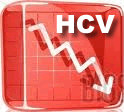U.S.
Hepatitis C Incidence Dropped 10-fold Over 2 Decades
 |
 |
 |
 |
| SUMMARY:
The incidence of acute hepatitis C virus (HCV) infection
in the U.S. has decreased dramatically over the past
25 years, falling from 7 to 0.7 cases per 100,000 people,
according to a CDC study published in the February
14, 2011, Archives of Internal Medicine.
In recent years nearly half of all new infections were
attributable to injection drug use, but about a third
had no identifiable risk factor. |
|
 |
 |
 |
 |
By Liz Highleyman
 Formerly
known as "non-A/non-B" hepatitis, HCV was identified in
the late 1980s. HCV is transmitted through direct blood contact.
Donated blood in the U.S. has been screened for HCV since 1992.
The most common route of transmission today is blood left on shared
needles and other drug-injection equipment.
Formerly
known as "non-A/non-B" hepatitis, HCV was identified in
the late 1980s. HCV is transmitted through direct blood contact.
Donated blood in the U.S. has been screened for HCV since 1992.
The most common route of transmission today is blood left on shared
needles and other drug-injection equipment.
Ian
Williams and colleagues with the Centers for Disease Control and
Prevention (CDC) used sentinel surveillance methods to determine
incidence (new infections) and transmission patterns of acute
hepatitis C in the U.S., looking at data from 25 years of general
population surveillance.
The researchers identified cases of acute HCV infection between
1982 and 2006 using a stimulated passive surveillance system in
4-6 U.S. counties. Cases were determined based on sudden onset
of symptoms and/or elevated alanine aminotransferase (ALT) liver
enzyme levels (> 2.5 times the upper limit of normal [xULN]),
positive HCV antibody or RNA tests, but negative hepatitis A and
B tests.
Clinical cases generally reflect only about 20% to 30% of all
newly acquired infections, they noted, since acute hepatitis C
is often asymptomatic.
Results
 |
A
total of 2075 individuals with acute HCV infection were identified,
with a median age of 31 years: |
 |
91.5%
had ALT values greater than 7 x ULN; |
 |
77.3%
developed jaundice, or yellowing of the skin and eyes; |
 |
22.5%
were hospitalized; |
 |
1.2%
died. |
|
 |
The average HCV incidence was 7.4 per 100,000 people (or about
70 per 1 million) during 1982-1989, falling to 0.7 per 100,000
(or 7 per 1 million) during 1994-2006. |
 |
Among
1748 patients interviewed, injection drug use was the most
commonly reported risk factor. |
 |
The
average number of injection drug-related acute infections
declined in parallel with the overall decrease. |
 |
However,
the proportion of injection drug-related cases rose from 31.8%
during 1982-1989 to 45.6% during 1994-2006. |
 |
Almost
all individuals (91.8%) with injection drug-related acute
hepatitis C during 1994-2006 had been in a drug treatment
program and/or incarcerated. |
 |
The
number of new HCV infections transmitted through blood transfusions
declined dramatically after the blood screening test became
available, and during 1994-2006 only 5 possible cases were
identified. |
 |
About
one-third of acute HCV cases had no identifiable risk factor. |
Based
on these findings, the study authors concluded, "The incidence
of acute HCV declined substantially over the 25 years of population-based
surveillance."
"Despite declines," they added, "injection drug
use is the most common risk factor for new HCV infection."
Investigator affiliations: Division of Viral Hepatitis, Centers
for Disease Control and Prevention (CDC), Atlanta, GA; Outbreak
Response and Prevention Branch, Division of Foodborne, Waterborne,
and Environmental Diseases, CDC, Atlanta, GA; National Center
for Emerging and Zoonotic Infectious Diseases, CDC, Atlanta, GA;
Office of the Director, National Center for Immunization and Respiratory
Diseases, CDC, Atlanta, GA; Division of Infectious Diseases, University
of Texas Medical Branch, Galveston, TX.
3/11/11
Reference
IT Williams, BP Bell, W Kuhnert, and others. Incidence and transmission
patterns of acute hepatitis C in the United States, 1982-2006.
Archives of Internal Medicine 171(3): 242-248 (abstract).
February 14, 2011.
